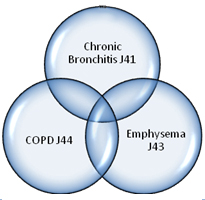|
August 2015
Coding corner update: Improve medical record documentation for chronic obstructive pulmonary disease and other associated respiratory conditions
Beginning Oct. 1, 2015, the transition to ICD-10-CM will affect every area of health care. Many codes contain much greater specificity. This article includes updated codes to align with the transition to ICD-10-CM.
In order to support the ICD-10-CM diagnosis code selected, chronic obstructive pulmonary disease and other associated respiratory conditions need to be properly documented in the medical record.

What’s COPD?
Chronic obstructive pulmonary disease is a common and progressive disease that makes it difficult to breathe. Common symptoms include coughing that produces large amounts of mucus, wheezing, shortness of breath and chest tightness. The two main forms of COPD are emphysema and chronic bronchitis. However, many patients with COPD have both emphysema and chronic bronchitis.
What causes COPD?
Smoking cigarettes is the leading cause of COPD. Most people who have COPD are either current smokers or have a history of tobacco use. Other causes include long- term exposure to lung irritants such as air pollution, chemical fumes and dust, all of which can contribute to COPD.
Tips to remember when coding COPD
When coding for COPD, bronchitis (acute, chronic), asthmatic bronchitis (acute, chronic), emphysema and other associated respiratory conditions, it’s important to properly code whether or not the condition is acute, chronic or in acute exacerbation.
- Due to the overlapping nature of the conditions that comprise COPD, code selection must be based on terms documented by the provider.
- ICD-10-CM code J44.9, chronic obstructive pulmonary disease, unspecified, should only be used if the type of COPD being treated is not specified in the medical record.
- It’s imperative to always document and code to the highest specificity. For example, if the provider states “acute bronchitis” or “chronic bronchitis,” (both unspecified) then report ICD-10-CM codes J20.9 and J42.0, respectively. However if the provider does not indicate whether the bronchitis was either acute or chronic, then the appropriate ICD-10-CM code would be J40: Bronchitis not specified as acute or chronic.
- When COPD with an acute exacerbation is documented without acute bronchitis, then report ICD-10-CM code J44.1: Chronic obstructive pulmonary disease with (acute) exacerbation.
- Code J44.0 (Chronic obstructive pulmonary disease with acute lower respiratory infection) when the medical record supports acute bronchitis and COPD. Use an additional code to identify the infection.
ICD-10-CM code |
Description of respiratory condition |
J41.0 |
Simple chronic bronchitis |
J41.1 |
Mucopurulent chronic bronchitis |
J44.– |
Other Obstructive pulmonary disease
J44.0 COPD with acute lower respiratory infection
J44.1 COPD with (acute) exacerbation
J44.9 COPD, unspecified |
J41.8 |
Mixed simple and mucopurulent chronic bronchitis |
J42 |
Unspecified chronic bronchitis |
J43.9 |
Emphysema, unspecified |
J45.– |
Asthma
J45.2- Mild Intermittent asthma
J45.3- Mild persistent asthma
J45.4- Moderate persistent asthma
J45.5- Severe persistent asthma
J45.9- Other and unspecified asthma |
R09.02 and J44.9 |
Hypoxemia and COPD
Please note that hypoxemia is not an inherent component of COPD (AHA, Coding Clinic, 2009, issue 3). |
Z93.0 |
Tracheostomy status |
Z99.11 |
Dependence on respirator; ventilator status |
J95.850 |
Mechanical complication of respirator |
Z99.81 |
Dependence on supplemental oxygen (You should code the underlying condition first.) |
Z43.0 |
Encounter for attention to tracheostomy |
It’s important to review the ICD-10-CM Coding Guidelines (Chapter 10: “Diseases of Respiratory System J00-J99”), as well as any instructional notes under the various COPD subcategories and codes in the tabular list of the ICD-10-CM manual, in order to select the correct code. In addition to the codes listed above it is important to include codes related to tobacco usage, dependence or other exposure.
ICD-10-CM coding for all conditions should follow coding conventions, chapter specific guidelines and general coding guidelines.
If you have questions or need more information, contact your provider consultant.
None of the information included in this article is intended to be legal advice and, as such, it remains the provider’s responsibility to ensure that all coding and documentation are done in accordance with applicable state and federal laws and regulations.
|